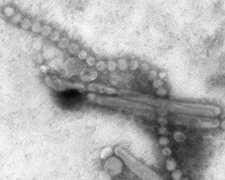Asian Lineage Avian Influenza A (H7N9) Virus
Background
Human infections with an Asian lineage avian influenza A (H7N9) virus (“Asian H7N9”) were first reported in China in March 2013. Annual epidemics of sporadic human infections with Asian H7N9 viruses in China have been reported since that time. China is currently experiencing its 5th epidemic of Asian H7N9 human infections. This is the largest annual epidemic to date. As of September 13, 2017, the World Health Organization (WHO) has reported 764 human infections with Asian H7N9 virus during the 5th epidemic, making the largest epidemic to date. This brings the total cumulative number of human infections with Asian lineage H7N9 reported by WHO to 1562. Additional infections have been reported, but not yet publically announced by WHO. During epidemics one through four, about 40 percent of people confirmed with Asian H7N9 virus infection died.
Epidemiology
Most human infections with avian influenza viruses, including Asian H7N9 virus, have occurred after exposure to poultry; Asian H7N9 viruses continue to circulate in poultry in China. Most reported patients with H7N9 virus infection have had severe respiratory illness (e.g., pneumonia). Rare instances of limited person-to-person spread of this virus have been identified in China, but there is no evidence of sustained person-to-person spread. Some human infections with Asian H7N9 have been reported outside of mainland China, but most of these infections have occurred among people who had traveled to mainland China before becoming ill. Asian H7N9 viruses have not been detected in people or birds in the United States.
CDC Risk Assessment
While the current risk to the public’s health posed by Asian H7N9 virus is low, the pandemic potential of this virus is concerning. Influenza viruses constantly change and it is possible that this virus could gain the ability to spread easily and sustainably among people, triggering a global outbreak of disease (i.e., a pandemic). In fact, of the novel influenza A viruses that are of special concern to public health, Asian lineage H7N9 virus is rated by the Influenza Risk Assessment Tool (IRAT) as having the greatest potential to cause a pandemic, as well as potentially posing the greatest risk to severely impact public health.
It is likely that sporadic human infections with Asian H7N9 virus associated with poultry exposure will continue to occur in China. There is also a possibility of Asian H7N9 virus spreading to poultry in neighboring countries and human infections associated with poultry exposure may be detected in neighboring countries. Asian H7N9 infections may continue to be detected among travelers returning from countries where this virus is present. However, as long as there is no evidence of ongoing, sustained person-to-person spread, the public health risk assessment would not change substantially.
CDC Response
The U.S. Government supports international surveillance for seasonal and novel influenza viruses with pandemic potential, including Asian lineage H7N9. CDC collaborates with clinical and public health laboratories located in all 50 states. Each week, these laboratories routinely test human respiratory specimens for influenza and report those results to CDC. Any suspected novel influenza A virus, including an Asian lineage H7N9, detected at a public health laboratory is forwarded onto CDC for confirmatory testing. CDC is following this situation closely and is coordinating with domestic and international partners. CDC takes routine preparedness actions to counter pandemic threats as they are identified, including developing candidate vaccine viruses (CVVs) to use for vaccine production in case vaccine is needed. CDC has prepared a risk assessment of Asian H7N9. Other routine preparedness activities include ongoing review of new viruses and virus sequences to assess their genetic and antigenic properties as well as their antiviral susceptibility. This information informs an ongoing risk assessment process, which guides further actions. CDC also has issued guidance to clinicians and public health authorities in the United States, as well as provided information for people traveling to China. CDC will provide updated information as it becomes available.
Asian H7N9 Outbreak Characterization

- Asian H7N9 virus infections in poultry in China
- Sporadic infections in people; most with poultry exposure
- Rare limited person-to-person spread
- No sustained or community transmission
H7N9: What should I do?
- CDC does not have any new or special recommendations for the U.S. public at this time regarding H7N9. CDC will keep you updated. Stay informed.
- Since Asian H7N9 is not spreading easily from person to person at this time, CDC does not recommend that people delay or cancel trips to China. The World Health Organization also is watching this situation closely and does not recommend any travel restrictions.
- CDC advises travelers to China to take some common sense precautions, like not touching birds and washing hands often. Poultry and poultry products should be fully cooked. CDC will update its advice for travelers if the situation in China changes. This guidance is available at Avian Flu (H7N9) in China.
Recently Reported
- Update: Increase in Human Infections with Novel Asian Lineage Avian Influenza A(H7N9) Viruses During the Fifth Epidemic — China, October 1, 2016–August 7, 2017
- Increase in Human Infections with Avian Influenza A(H7N9) Virus During the Fifth Epidemic — China, October 2016–February 2017
- Antigenic and genetic characteristics of zoonotic influenza viruses and candidate vaccine viruses developed for potential use in human vaccines
- World Health Organization report: “Human infection with avian influenza A(H7N9) virus – China”
- World Health Organization report: ”Analysis of recent scientific information on avian influenza A(H7N9) virus”
- MMWR report: “Assessing Change in Avian Influenza A(H7N9) Virus Infections During the Fourth Epidemic — China, September 2015–August 2016.”
- Page last reviewed: September 20, 2017
- Page last updated: September 26, 2017
- Content source:
- Centers for Disease Control and Prevention, National Center for Immunization and Respiratory Diseases (NCIRD)
- Page maintained by: Office of the Associate Director for Communication, Digital Media Branch, Division of Public Affairs


 ShareCompartir
ShareCompartir